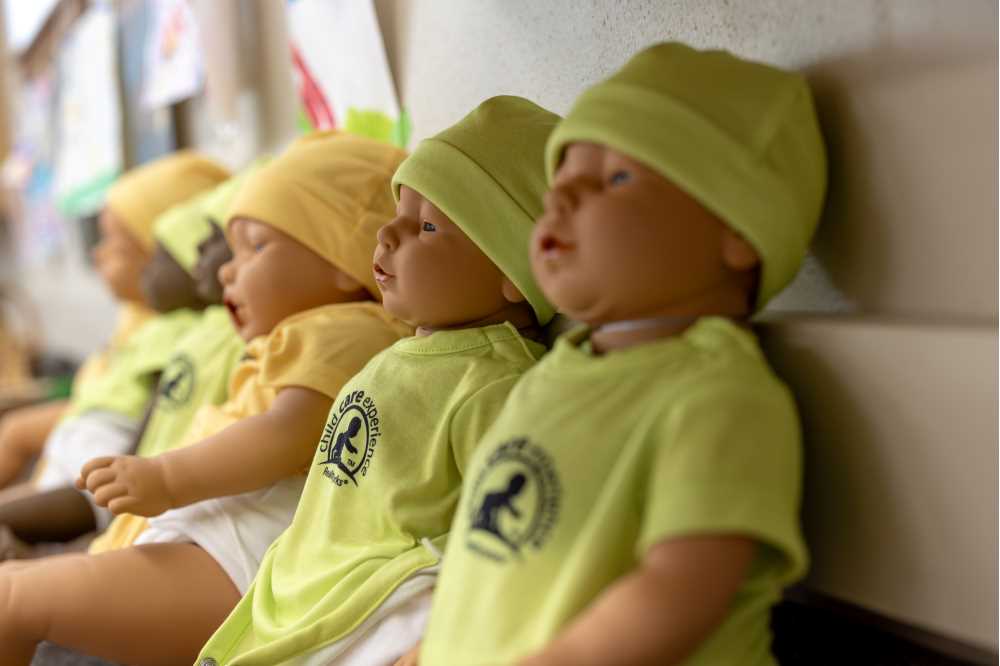Posted 8:40 a.m. Thursday, Nov. 13, 2025

Early childhood education students benefit from new classroom, certification, pedagogies
In the lower level of Morris Hall, a classroom with deep roots in UW-La Crosse history has been reimagined for a new generation of teachers.
Room 105, once home to kindergarten classes as early as the 1950s, has long served as a hub for early childhood education. But over time, the space no longer reflected the vibrant, collaborative learning that defines UWL’s Early Childhood and Early Childhood Special Education (ECE-SPE) programs.
“We value and celebrate that history,” says Val Krage, assistant professor and ECE-SPE program director. “But the space has become outdated and too small, especially with the growth we anticipate in our new dual-certification program. The room layout made even simple movement difficult; students literally couldn’t pull out their chairs without disrupting those around them. We knew we needed a space that would be both comfortable and truly conducive to learning.”
Now, after a full remodel, Room 105 has been transformed into a warm, modern learning environment designed to emulate the classrooms UWL students will one day lead. The space offers flexible seating, open floor plans for collaboration, and new technology bridging theory and practice.
“The remodel provides our students with room to work collaboratively,” Krage explains. “Whether they’re engaged in curricular planning, learning how to implement creative arts activities for their future students or facilitating learning experiences for the children from Campus Child Center, 105 is now much more conducive to a variety of teaching and learning activities.”
A classroom that teaches by example

Beyond new furniture and finishes, the space itself has become part of the curriculum.
Students in early childhood courses now personally experience how physical space shapes learning — a lesson they can carry into their own classrooms.
“In our early childhood courses, we address the importance of classroom aesthetics for optimal learning,” Krage says. “Our newly remodeled classroom provides students with firsthand knowledge of how physical space impacts focus, collaboration and overall well-being. The updated environment is more comfortable and inviting, fostering a sense of calm and comfort that mirrors the kind of supportive classrooms our students will one day create for their own learners.”
Students have already noticed the difference.
“The remodeled classroom has improved learning and collaboration by creating a space that connects us as one learning unit working together to achieve our goals,” says Robin Anderson, a senior majoring in ECE and vice president of the ECE Club. “The ample room for individual space and improved technology allows us to engage with resources and materials easily, and our instructors’ efforts to fill this space with relevant décor and materials to our ECE field generate a welcoming and enriching atmosphere.”
The changes have gone beyond class time, too.
“With these new improvements, the classroom has now even become the home of our monthly Early Childhood Education Club meetings,” Anderson adds. “This new learning environment nurtures our academic growth, creativity and sense of belonging within our ECE community.”
Bringing real-world caregiving into the classroom
This year, the Early Childhood Education program also launched two major enhancements: a dual certification pathway in Early Childhood and Early Childhood Special Education, and the introduction of infant simulation dolls that bring real-world caregiving into the classroom.
“The simulation dolls give students hands-on practice with responsive caregiving by simulating feeding, diapering, rocking and other real-life infant care tasks,” Krage explains. “These babies cry, need to be fed, rocked and changed, and they respond to how the student interacts with them.”
By working with the dolls, students gain practical experience understanding both the joys and challenges of infant care.

“The dolls enhance the ability of students to connect theory to practice, offering experiential learning that prepares them to support all children, including those with diverse needs,” Krage says. “Students in the dual certification track can use the dolls to practice inclusive caregiving approaches, such as supporting sensory needs, anticipating developmental differences and strengthening family partnerships.”
Faculty are also incorporating the dolls into assignments that bridge early childhood and special education concepts, helping students link developmental theory with equity-minded practices.
Feedback about the redesigned classroom and new technology has been overwhelmingly positive.
“Students have responded very positively to the new space,” Krage notes. “They’re thrilled to have a learning environment that feels much more comfortable and inviting.”
Barbara Chaney, former chair of the Early Childhood Education program, hopes the new space will engender the same sense of community that existed in the old classroom many years ago.
"The best part of the ECE classroom and program was the family and community feel," she says. "The classroom was something that was our very own, something just for early childhood, and we loved it."
With its fresh design and hands-on tools, Room 105 honors UWL’s proud history in early childhood education, while positioning the program for a bright future. What began as a space for kindergarteners now inspires the next generation of teachers.
